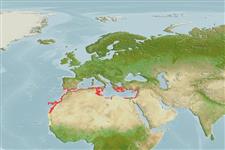| Native range | All suitable habitat | Point map | Year 2100 |

|
| This map was computer-generated and has not yet been reviewed. |
| Rhinoptera marginata AquaMaps Data sources: GBIF OBIS |
Human uses
Fisheries: commercial
Phylogenetic diversity index
(Ref. 82805)
PD50 = 0.5039 many relatives (e.g. carps) 0.5 - 2.0 few relatives (e.g. lungfishes)
Trophic Level
(Ref. 69278)
3.8 ±0.60 se; Based on food items.
Resilience
(Ref. 69278)
Very Low, minimum population doubling time more than 14 years (Fec=2)